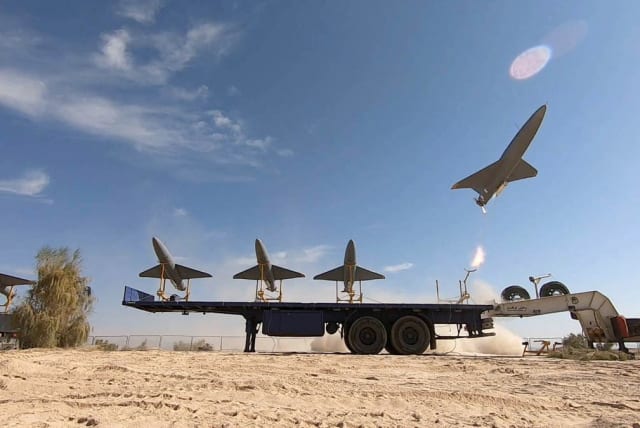After surprise Tel Aviv attack, Houthi drone arsenal comes under spotlight - analysis

In-depth analysis of how Iranian-backed Houthis turned to drones in Yemen's civil war, creating a formidable, cost-effective aerial arsenal that gained them the upper hand in the region.
The Iranian-backed Houthis have been using drones for a decade, beginning during the civil war in Yemen. When Saudi Arabia intervened in Yemen to prevent the Houthis taking over Aden and other key parts of the country in 2015, the Iranian backing for them increased. This helped them develop a large arsenal of drones.
The Houthis chose to develop drones, because this was a cheap way to create a kind of instant air force. They don’t have any resources, and their power comes from their relatively impoverished supporters in the mountains of Yemen.
With Iranian support, however, they built an impressive arsenal of missiles and drones. They used these to terrorize Saudi Arabia after 2015. They used kamikaze drones, for instance, to attack air defense radars.
The first Houthi drones were simple, and the Houthis soon invested in kamikaze drones based on the Iranian Ababil drone family. The Qasef-1 was the first important Houthi kamikaze drone. By July of 2019, the Houthis had developed as least eight types of drones, which were put on display at an event.They included the Qasef-1 and its successor, the Qasef-2K. It also included several drones from the Sammad family, including the Sammad-1, 2 and 3. They also have drones called the Hudhud, Raqib and Rased.
To get an idea of the size and capabilities of these drones, let’s take a look at a few of them. For our purposes, the Houthi surveillance drones, such as the Hudhud, Raqeed and Rased do not matter that much – they are small and don’t have a long range.
Houthi drone types and capabilities
But the Qasef had an initial range of around 160 kilometers and was about three meters long. It also had a three-meter wingspan. With its warhead, the kamikaze drone weighs up to 90 kilograms and flies at a speed of around 320 kilometers per hour. The Qasef has a strange design, with long wings at the back and short wings in the front. In this respect it has some similarities to a cheap cruise missile.
The Qasef series of drones were soon bolstered by the Sammad series, which look kind of like a large model airplane. They have a simple, long rectangular wing, a V-shaped tail, and a fuselage that looks like a long tube. They can carry a warhead in the fuselage and also be used as kamikaze drones. This kind of design for a drone is one that the Houthis likely borrowed by looking at other drone designs, such as Israel’s Hermes-450.
The Sammad range was increased over time to more than 1,600 kilometers. These drones are not that heavy, usually not exceeding 45 kilos in weight. Their warhead might be around nine to 18 kilos of explosive. These specifications can likely be changed to squeeze out a longer range.
In late 2020, the Yemen-based terrorists also acquired the Iranian Shahed 136 drone. A kamikaze drone, its wings are delta-shaped, making it look basically like a flying triangle. It is not very large, only about three meters long and weighing around 180 kilograms.
Fabian Hinz, an expert at the International Institute for Strategic Studies posted a thread on X that discussed what type of drone might have been used in the attack on Tel Aviv. He identified it as probably a Sammad drone.
In a photo of the engine of the drone, he said that “the one thing I find notable is the use of a Mado 275 engine. Most Sammads I have seen seemed to use the less powerful DLE 170.” The type of engine is important because it can be traced back to a manufacturer in many cases. Iran has sought in the past to acquire engines from Europe or China. A Hezbollah supporter was recently detained in Germany for seeking to acquire drone parts, including engines, to be sent to Hezbollah in Lebanon.
The Houthi drone arsenal is impressive. They have terrorized shipping and their range appears to be expanding. However, the drones don’t have large warheads and the amount of destruction they can cause has so far been limited.
Nevertheless, they are a weapon that can be programmed for precision strikes on various targets. This makes them very dangerous. The Houthis have developed this arsenal of drones with Iranian help. The Yemeni terrorists should be expected to continue to expand their drone arsenal. This is also true of Hezbollah in Lebanon.
All the Iranian proxies use similar drone designs and families, from the Shahed delta-wing types to the more simple tube-shaped body of the Sammad. Both the Houthis and Hezbollah claim they are building drones that have sleeker, stealth designs. They may also try to alter the engines to use more quiet electric ones. However, they will always face issues relating range, size and weight, as well as the energy supply for the engine.
Jerusalem Post Store
`; document.getElementById("linkPremium").innerHTML = cont; var divWithLink = document.getElementById("premium-link"); if (divWithLink !== null && divWithLink !== 'undefined') { divWithLink.style.border = "solid 1px #cb0f3e"; divWithLink.style.textAlign = "center"; divWithLink.style.marginBottom = "15px"; divWithLink.style.marginTop = "15px"; divWithLink.style.width = "100%"; divWithLink.style.backgroundColor = "#122952"; divWithLink.style.color = "#ffffff"; divWithLink.style.lineHeight = "1.5"; } } (function (v, i) { });

